What is a Sustainable Office Design?
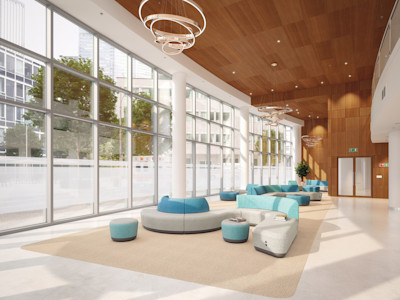
A noticeable shift is occurring as companies increasingly prioritize social responsibility. Social responsibility has become a priority for some employees and can even have a bearing on the company they choose to work for. The social mission or social responsibility that companies choose to embrace varies greatly, but a trend that is more and more prevalent is sustainability. This is leading us to a sustainable office design. Sustainability can look different, but there is always a common goal; reducing your environmental imprint. Many companies and organizations have days that are dedicated to specific efforts such as planting trees or spreading awareness, but one thing that you might not think about when talking about sustainability is office design. Office design might sound like a difficult way to promote sustainability, but you’re more than likely already using a few of the most common practices. The way you design your office can impact the efficiency and conservation of utilities. The furniture you decide to use can reduce your impact on the environment. And certain business models can have an effect on individual employees’ contribution to sustainability. But are these decisions intentional, and are they at the forefront of an organization’s mind? The answer is yes.
Automation
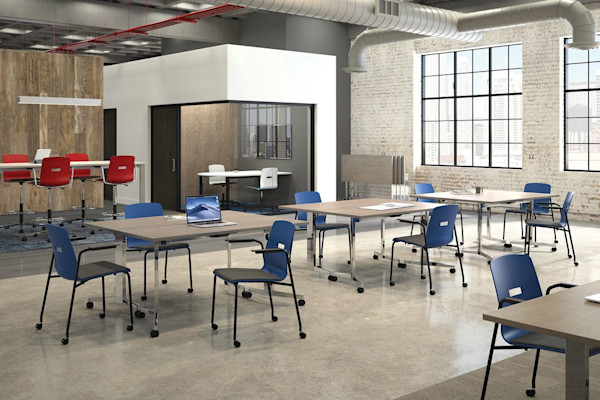
>>Find modern office furniture that can be seamlessly integrated with AI.<<
With the introduction and adoption of AI technologies, office design is incorporating automation in design. Using AI to automate utility usage is helping companies reduce operation costs and more importantly, conserve energy. Employee monitoring can help companies observe the behavior of employees. This helps provide them with real-time, measurable outcomes that will allow them to make adjustments. Inefficiently managing utilities can lead to unnecessary waste, but it doesn’t have to. AI and machine learning can help monitor the number of employees in a space and adjust the utilities accordingly. These automation systems can control lighting, heating, and air conditioning. Using AI and automation in an office design is an easy and simple way for companies to prevent overuse and waste in the office.
The Hybrid Model and Sustainable Office Designs
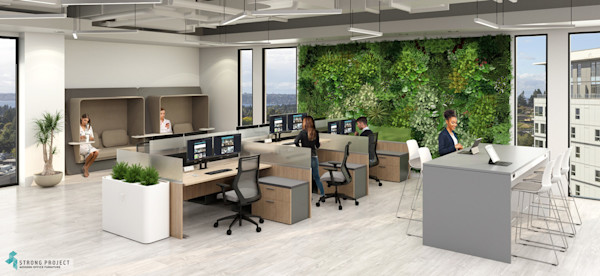
>>Strong Project's hybrid office furniture can help you develop a sustainable office design.<<
A company’s business model can greatly influence efficiency, employee satisfaction, and a successful work-life balance. The business model can also have an impact on sustainability. The hybrid office uses a unique office design. Shared spaces, efficiently designed areas, and limited office spaces are all characteristics of the hybrid model. Another potential characteristic of the hybrid model is sustainability. If implemented correctly. Hybrid models limit the time spent in the office. This idea can lead to a more sustainable office. Since a hybrid model uses less space, companies are able to reduce the size of their office, the amount of furniture, and their utility usage. Along with the effect the company and the actual office itself have on the environment; the hybrid model gives employees the chance to have their own individual impact. Switching from a 5-day onsite work week to a 2, 3, or even 4-day work week reduces the commute for employees. This allows them to greatly reduce their carbon emissions. The office design of a hybrid model is unique. A properly designed hybrid office has multi-functional furniture and collaborative spaces to provide employees with resources they are unable to replicate at home. Our hybrid office furniture collection is full of options that can help contribute to an overall goal of sustainability.
Natural Lighting
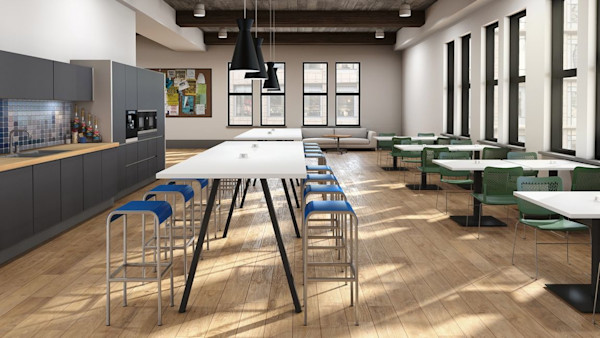
>>Natural light is an office must-have for the environment and employee well-being.<<
One of the most important parts of an office is the lighting. Office design has a huge impact on how well we’re able to optimize natural light. Using natural light affects employees and how they work, but it also contributes to sustainability. Harnessing the power of natural light will reduce and, in some cases, eliminate the need for artificial light. Using less artificial light reduces a company’s carbon footprint and conserves energy. Taking natural light into consideration when designing an office is important for sustainability. Although architects and developers have the power to design a building around how well the tenants will receive natural light, designing an office in an existing space can sometimes be pretty difficult. Before companies design or redesign a space, they can take into account how much natural light an area will receive and the times they’ll receive it. Knowing where and when employees will be able to utilize natural light will determine the type of furniture, the office layout, and areas where offices will have to compensate for artificial light. Aside from sustainability, natural light has a great impact on mood, productivity, and efficiency. This helps avoid health risks associated with fluorescent lighting. Companies that use and optimize natural lighting are also able to increase property values and make an office or area a more desirable space to work in.
Furniture
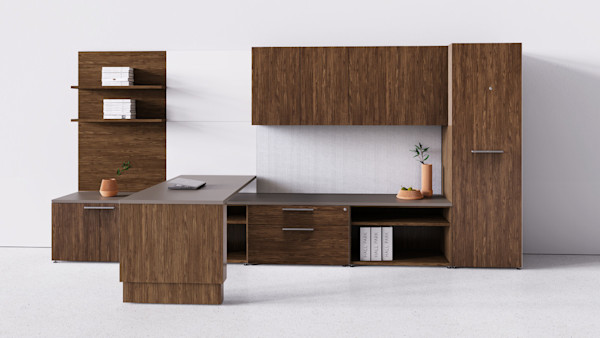
>>Learn more about our quality and durable furniture.<<
Choosing the right furniture in your modern office design can have a greater impact on the environment than you might think. Sustainably sourced materials, and furniture with a long life, durability, and quality can all have a long-lasting impact on the environment. Updating furniture and redesigning can be necessary, but once the furniture leaves the office, where does it go? A recent study from the Environmental Protection Agency determined that office furniture is one of the major contributors to landfills. Each year 17 billion pounds of office furniture enters landfills. This might be due to upgrades, companies wanting to change their aesthetics, or a change to better the office design. It's also attributed to poor quality and limited lifespan. While the average age of office furniture is close to a decade, it could be much longer. Many of the large and sturdy pieces that are subject to less wear and tear such as desks and storage solutions will have a longer life. However, the quality of the pieces can extend the lifespan a little longer. Furniture that is made with quality materials won’t look as worn down as their cheaper counterparts. In some cases, certain pieces will wear down quicker, and replacing them sooner is inevitable. Office chairs are less likely to last as long. That’s why it’s even more important to find quality, ergonomic designs that will stand up to high usage.
Sustainability and Materials
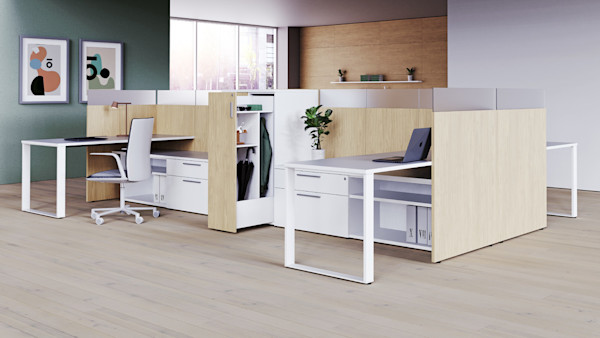
>>Looking for quality and long-lasting office furniture? Find it here.<<
Where an office furniture company sources its materials from can have a detrimental effect on the environment. Not using sustainable practices causes the depletion of natural resources. Using sustainable materials helps with this issue. Most office furniture uses similar materials: wood, metal, and plastic. These three materials that are likely in every piece of furniture around you, have an opportunity to be sustainably sourced or recycled. Wood is used in almost everything around us. It’s the way we harvest it that can have a lasting impact on it. Deforestation and over-harvesting can have a major impact on ecosystems and many other environmental factors. When timber is sourced sustainably it often comes from properly managed forests to prevent over-harvesting and a negative effect on the land itself. Steel and plastic are other materials that can be found in many different products, but these materials are easily recycled. Recycling plastics and steel can help reduce the amount of waste that enters our landfills daily. Being aware of how the materials are sourced and what’s available in those categories can greatly impact sustainability and office design.
Going Green Can Save Green
There are many practices that can promote sustainability while saving money. Reducing utility usage, using recycled materials, and choosing furniture that will last long term can save on operation costs as well as long-term expenses. Reducing our environmental footprint usually requires using less of something. Less power, less water, and replacing furniture requires less spending. Although the motivation for green initiatives is usually a social mission and part of a company’s image, the impact it has on spending can be huge.
Should you Embrace a Sustainable Office Design?
Yes. Sustainability should be at the forefront of your mind when making decisions about your sustainable office design. It doesn’t take much to contribute to sustainable practices. By altering on-site work policies and investing in durable, high-quality furniture, companies have the flexibility to integrate sustainability to the extent they are able. Companies are making many of their decisions these days based on the impact they’re having on the environment. We’re seeing freight companies switch to electric vehicles, entire office buildings powered by renewable energy, and companies setting out to be carbon neutral within the next decade. If these major changes are being implemented by industries, then designing a green, sustainable office should be something we should all consider. Take the first step toward a sustainable office design by contacting StrongProject today. Want to learn more about hybrid office design? Check out our comprehensive guide!



